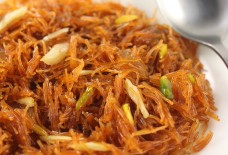Ziad Rahbani: A Lebanese Icon

By Luke McMahan / Arab America Contributing Writer
When speaking of Ziad Rahbani (زياد الرحباني), one immediately mentions that he is the son of one of the most famous and beloved Arab artists of all time: Nouhad Haddad, known better as Fairouz. She, who captured the hearts and minds of millions with a divine and ethereal voice sung over perfectly crafted classical instrumentation, was married to one half of another Arabic music powerhouse, Assi of the Rahbani brothers.
With their work with Fairouz and several successful plays, the duo left an indelible mark on future Arabic popular music. In contrast with their sublime classics, Ziad gained prominence during the Lebanese Civil War for a unique brand of witty, sardonic, nihilistic, and deeply mocking theater, radio, and music. While he is now known mainly as a leftist revolutionary artist, his criticism evades easy political labels and markedly evolved through different periods of Lebanese history.
Music
Before delving into Ziad’s solo work, mentioning his collaborations with his mother is important. Many of these, such as the songs “Oudak Rannan” and “Al Bostah,” lend Fairouz more energy and edge than her well-known classical compositions. Most famously, at age 17, he first earned major artistic recognition for producing his mother’s hit “Saalouny Nas,” which still stands as one of her most famous songs.
The two most famous Ziad Rahbani albums represent different approaches in his musical work: direct political critique and avante-garde pop infused with more subtle commentary. The former, Ana Moush Kafer, which translates to “I Am Not a Heathen,” is the one example in his work of overt engagement with his leftist political beliefs and the album most talked about in academic contexts.
The title track opens with an ordinary man defending himself from accusations of heathenism, saying that hunger, sickness, and poverty are real heathens, and what else can he do if these heathen things lead him to struggle to survive. Conversely, the supposedly devout elites are the ones causing this social injustice, which is the real cause of instability, while at the same time using this religious identity to avoid change to the system. In the rest of the album, he routinely employs dark humor to augment more commentary on politics and life during wartime.
In contrast, Houdou Nisbi, which translates to “Relative Calm,” is more representative of his overall musical oeuvre and contains his most beloved songs. “Bala Wala Shi” or “Without Anything,” imagines a relationship unfettered by money, parental restrictions, or any other outside consideration.
Songs like this contain subtle critiques of capitalism and representations of young Lebanese men beset by various social obligations and material obstacles, all within the trope of the pop love song. This album also heavily features jazz, bossa nova, and other non-Arab genres with Arab twists. This music, as well as the non-traditional compositions he wrote for Fairouz, earned him some criticism from other Arab artists for his departure from popular music norms.
Radio and Plays
Rahbani also used radio productions and speeches as outlets for his criticism of major Lebanese individuals and groups. This medium was simultaneously wide-reaching and less restrictive, allowing him great freedom in his message and helping him rise to the status of a cult icon. While he identified as a communist and had links to the Lebanese Communist Party, he did not limit his vitriol to the right. In brief sketches and direct commentary, he and filmmaker Jean Chamoun ridiculed mannerisms, overused jargon, and political speeches. Their understanding of the sources of Lebanon’s political and social ills was adept, widely encompassing, and in tune with the beliefs of the majority of the population.
Finally, Rahbani’s plays provided yet another side to his critical campaign: nihilistic irony commentating on society. In contrast with the celebratory nationalism in his father and uncle’s plays, Ziad’s productions parody various stereotypes and archetypes of national, regional, and world actors in an eventual deconstruction of meaning and reason amid unfavorable political conditions. Such productions as Film Amriki Tawil (“Long American Film”) and Shi Fashil (“Failure”) display his “paradoxically light atmosphere”(Kattar) filled with jokes and puns that eventually culminate in a final tragic state of misery and futility for the general public.
This fits with a growing disillusionment and a general abandonment of outright revolutionary themes in his work. His relationship with the broader Lebanese population is complicated throughout these plays: he accurately represents their frustrations and criticisms within a corrupted system; yet, as time progresses, Rahbani eventually places some blame on them for allowing it to continue, too passive and sectarian to meaningfully rebel. Regardless, these plays remain some of Ziad’s most beloved work at the time.
Attempting to nail down Rahbani’s central beliefs and artistic characteristics is difficult. As mentioned, he was a dedicated leftist and communist supporter, yet he spared no targets from his biting, sardonic criticism. Thus, the Lebanese populace, even those who differed politically from him, respected and praised his art not only for its accurate representation of their own concerns but for its impartiality. These qualities, in combination with his revolutionary defiance, keep his work, especially from the late 70s and 80s, relevant to younger generations.
But Rahbani’s career progressed differently with the end of the Civil War in Lebanon; his plays and music engendered less critical and public praise in the 90s onward. Furthermore, Ziad himself has suffered some condemnation for his controversial public statements on Middle Eastern geopolitics in the decades to follow. Many believe that his greatest artistic production “was born out of the war but also for the war itself, as it’s cursed forever with the heavy burden of war memories”(Kattar). Nevertheless, Rahbani is truly an icon, living up to his parents’ name while forging his path innately tied to the Lebanon he grew up in.
Sources:
Haugbolle, Sune. “THE LEFTIST, THE LIBERAL, AND THE SPACE IN BETWEEN: ZIAD RAHBANI AND EVERYDAY IDEOLOGY.” The Arab Studies Journal 24, no. 1 (2016): 168–90. http://www.jstor.org/stable/44746851.
Kattar, Chloe. “The Artistic Universe of Ziad Rahbani: The Quest of a Dissident in Service of the Darawish.” In Generations of Dissent: Intellectuals, Cultural Production, and the State in the Middle East and North Africa, edited by Alexa Firat and R. Shareah Taleghani, 80–106. Syracuse University Press, 2020. https://doi.org/10.2307/j.ctvz9383k.9.
https://www.jadaliyya.com/Details/27192
https://web.archive.org/web/20150402152321/http://english.al-akhbar.com/node/12871
https://www.latimes.com/archives/la-xpm-1988-04-14-ca-1767-story.html
https://lyricstranslate.com/en/bala-wala-shi-بلا-ولا-شي-without-anything-else.html
https://lyricstranslate.com/en/ana-much-kafir-im-not-blasphemer.html
Check out our blog here!









